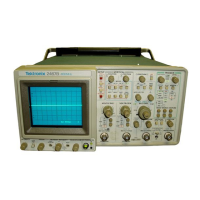Performance Check—2465B/2467B Service
1.
Function Generator (60 Hz, 30 kHz and 80 kHz)
2.
Primary Leveled Sine-Wave Generator (50 MHz)
3. Secondary Leveled Sine-Wave Generator
(500 MHz)
NOTE
To obtain signal amplitudes less than 1
division, first set the signal for either 4, 5,
or 10 times the specified amplitude, then
reduce the amplitude by a factor of
4,
5, or
10 by increasing the VOLTS/DIV settings
as necessary.
c. For each combination listed in the table, set the
gen-
erator Test Frequency and the oscilloscope TRIGGER
COUPLING as indicated, performing the following steps to
verify the Triggering levels in each setup.
d.
Set the VOLTS/DIV and the generator output level to
obtain the test signal amplitude indicated for the particular
combination being tested. When checking channel 1 and
channel 2 500 MHz triggering, also adjust the VOLTS/DIV
VAR for the correct input level.
e. Set the A SEC/DIV and the X10 MAG to obtain a
well-defined display of the test signal.
NOTE
Normally, unless trigger sensitivity is very close to
the specified limits, it is sufficient to check each of
the indicated frequency-coupling combinations listed
in the table in Channel 1
only;
checks for Channels
2, 3 and 4 need only be done in DC COUPLING (to
verify signal path).
f. CHECK—For a stable triggered display (unless other-
wise indicated) for each of the Test Frequency-TRIGGER
COUPLING combinations listed in Table 4-5. When testing
the 300 MHz triggering, check that trigger jitter is
< 100 ps (0.2 division at 5 ns/div with X10 MAG), with 5
divisions of signal and TRIGGER LEVEL adjusted for
minimum jitter.
g.
Press the ADD button to select the function and
press the CH 1 button to turn off the CH 1 display.
h. Repeat the DC TRIGGER COUPLING tests of Table
Table 4-5
CH 1 or CH 2 Triggering Conditions
Test
Fre-
quency
60 Hz
30 kHz
80 kHz
50 MHz
300 MHz
500 MHz
Minimum Vertical Display Levels at Which
Triggering Should Occur
TRIGGER COUPLING
DC
a
a
a
0.35
Div
1.0
Div
1.5
Div
NOISE
REJ
a
a
a
1.2
Div
3.0
Div
4.5
Div
HF REJ
a
0.35
Div
a
No Trigger,
Freeruns
at 1.2 Div
No Trigger,
Freeruns
at 3.0 Div
a
LFREF
No
Trigger,
Freeruns
a
0.35
Div
0.35
Div
1.0
Div
1.5
Div
AC
0.35
Div
a
a
0.35
Div
1.0
Div
1.5
Div
"Not necessary to check.
4-5 while in the ADD mode, adding 0.5 DIV to the 300 and
500 MHz amplitudes.
i. Move the signal to the CH 2 input connector and
repeat step h for CH 2.
j.
Press the CH 2 button to select the channel and
press the ADD button to turn off the ADD display.
k. Repeat the DC TRIGGER COUPLING tests of Table
4-5 while in CH 2 mode.
I. If trigger sensitivity is close to the specified limits
given in steps c through k above, test all of the
frequency-coupling combinations given in Table 4-5 for
CH 2.
m. Move the test signal to CH 3 and CH 4 in turn and
repeat parts c through f using Table 4-6.
4-16

